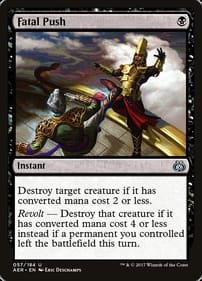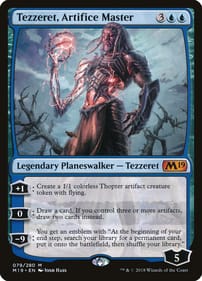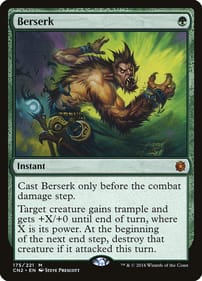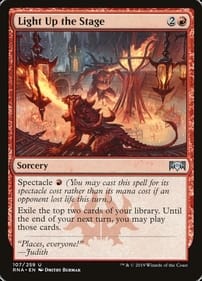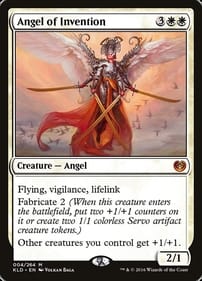Let’s go through the breakdown and go through the tips and tricks of the deck that has existed since the inception of Modern: Jund, an original Shard of Alara.

by Kuang Wu
Jund is a skill-testing deck that rewards knowledge of the metagame. Playing against another fair deck in UW Control is one of the most balanced matchups in Modern.
The deck consists of cheap and effective removal spells, powerful creatures, and Planeswalkers in tandem with disruption spells like Thoughtseize, and Inquisition of Kozilek to stop other game plans and get to the point of the game where you outlast your opponent.
Let’s take a look at the deck:
Creatures: 13
2 Kroxa, Titan of Death’s Hunger
Spells: 24
Lands: 23
1 Forest
1 Mountain
2 Swamp
Sideboard: 15
Jund has changed a lot over the years and through various metagames.
Modern Horizons gifted the deck a number of tools that changed some of the key pieces, most notably, Wrenn and Six replacing Dark Confidant.
Wrenn and Six’s -1 ability being able to eliminate an opposing Dark Confidant made it the obvious choice to be replaced by the Planeswalker.
The omission of Dark Confidant frees up any deckbuilding constraints and would allow the deck to play a card like Tasigur, the Golden Fang without the fear of losing 6 life in the upkeep.
Seasoned Pyromancer has recently overtaken Tireless Tracker as the 3 drop creature of the deck. Both serve as a way of generating card advantage, however the ability to create tokens for a format teeming with aggressive creatures has Seasoned Pyromancer the edge. It also synergises with newcomer Kroxa, Titan of Death’s Hunger, as you can discard it to Seasoned Pyromancer, create a token, and help fuel the graveyard to Escape Kroxa as soon as the following turn!
Strategy
Jund is a deck based on attrition, using discard in Thoughtseize, Inquisition of Kozilek, and Liliana of the Veil to take away key cards from the opposition’s game plan.
Using the diverse removal suite in Fatal Push, Lightning Bolt, Assassin’s Trophy, and Maelstrom Pulse to clear threatening creatures and permanents.
Generally, you want to lead with a discard spell—except in the instance, your opponent plays a mana creature like Llanowar Elves, Arbor Elf, Noble Hierarch, or Birds of Paradise—stopping your opponent from casting their 3 drop follow-ups, and also allowing your discard spell to pinch it the following turn. Hence the term ‘Bolt the Bird’.
By trading one-for-one efficiently, Kolaghan’s Command, Wrenn and Six, Seasoned Pyromancer, and Bloodbraid Elf are draws that will enable you to generate card advantage and gain an edge over your opponent. When the dust settles, it’ll be your Tarmogoyf or Kroxa, Titan of Death’s Hunger against an opponent with no remaining resources.
The deck just plays fair Magic, relying on resource denial. Something that was near impossible to do with Uro, Titan of Nature’s Wrath in the format. The banning of Uro has allowed the deck to better adjust to a metagame where resources are more easily denied.
Mulligans
In an unknown matchup, you generally want either Inquisition of Kozilek or Thoughtseize in your opening hand, to see what your opponent is playing and working with.
In addition to this, you want a few removal spells, to answer the various threats your opponent may present. By sequencing your discard spell first, you’re able to use your removal spells more efficiently.
For example, if you see your opponent has two copies of Soul-Scar Mage in their hand, and you have Maelstrom Pulse in yours, you should elect to take another creature or spell and hope to bait your opponent into playing both copies of Soul-Scar Mage. That way, you can clean them both up with your Maelstrom Pulse.
You also want two threats to compliment your hand: a combination of creatures and Planeswalkers to follow up from your discard and removal spells.
Against a Control deck, taking their counterspell with your discard spell will ensure you can land a threat like Wrenn and Six or Liliana of the Veil, which is pivotal to winning in the matchup.
For lands, you ideally want two in your opening hand: one of which being a fetch so you can recur Wrenn and Six to ensure you continue to make your land drops.
The deck does require a very specific mana base: Red/Green for Wrenn and Six, Red/Red for Seasoned Pyromancer, Black/Black for Liliana of the Veil, Green for Scavenging Ooze and it’s activated ability, and both double Red and double Black to Escape a Kroxa, Titan of Death’s Hunger.
With no Green one-drop spells in the deck, Blood Crypt should be the first land you should fetch or play, along with Blackcleave Cliffs. This will unlock Lightning Bolt, Fatal Push, and your discard spells.
A Green source should be your second target, to ensure you have access to all three colours. Although it may be tempting to find a Basic Forest as your second land, this will delay escaping Kroxa, Titan of Death’s Hunger.
The deck mulligans well, and a mix of lands, threats and disruption are enough to keep. Discard spells can function as pseudo removal spells, removing a threat from your opponent’s hand, rather than requiring a removal spell to eliminate it from the battlefield.
This can change if you know what deck you’re facing, opting to mulligan away cards with minimal impact (e.g. Fatal Push against Control).
After sideboarding, you should utilise mulligans to look for cards sideboarded in. Fulminator Mage against a Land or Big Mana deck will do a lot of work, as will graveyard hate against a deck like Dredge, and Plague Engineer against Tribal decks.
The inclusion of Unravel the Aether in the board is for its utility as a Naturalize effect. However, the ability to tuck the Artifact or Enchantment into the deck is to work around the indestructibility of Heliod, Sun-Crowned, as well as avoiding Wurmcoil Engine’s death trigger. The card is identical to Deglamer, so either work in the sideboard.
Other options for the sideboard depending on the metagame include:
- Nihil Spellbomb
- Ancient Grudge
- Collector Ouphe
- Weather the Storm
- Anger of the Gods
- Klothys, God of Destiny
- Boil
Tips & Tricks
With Bloodbraid Elf and Cascade in general, the spell being cascaded into is cast first. In the instance Bloodbraid Elf flips into Thoughtseize or Inquisition of Kozilek, an opponent cannot use a removal spell in their hand to target Bloodbraid Elf as it has not yet resolved and entered the battlefield.
However, on the inverse, a Bloodbraid Elf cascading into Liliana of the Veil provides your opponent with a window to Lightning Bolt the Liliana before you can activate it. With a Planewalker cast regularly, priority isn’t given to your opponents after it resolves, so you’re able to use its +1 ability before an opponent can attempt to remove it. With the case of Cascade, Bloodbraid Elf is still on the stack so your opponent has the opportunity to respond before you regain priority. The same applies to Wrenn and Six.
With 8 mana in addition to Raging Ravine available, you’re able to activate its ability twice. This will grant the 3/3 Raging Raving 2 +1/+1 counters. The land will often become a finisher once both player’s resources have been depleted due to a card like Liliana of the Veil.
Tarmogoyf is a creature that's Power and Toughness changes based on the card types in the graveyard. If your Tarmogoyf is a 2/3 with Sorcery and Land in the graveyard, it won’t die to Lightning Bolt. This is because 3 damage will be dealt to Tarmogoyf, but upon resolution of Lightning Bolt it’ll move to the graveyard, boosting it to a 3/4 and leaving it alive. This is also the case with Dismember if there are 4 non-Instant card types in the graveyard.
With a large portion of the deck being reprinted in Time Spiral Remastered and potential additions from the Witherbloom colours in Strixhaven, there hasn’t been a better time to start playing Jund!
About the author
Kuang Wu has played Magic since the original Zendikar set. Qualifying for both Player’s Tours in 2020 and finishing 10th at Grand Prix Brisbane in 2017. He primarily plays Modern at Good Games Central and Town Hall. You can follow him @kuangfupanda on Twitter.


